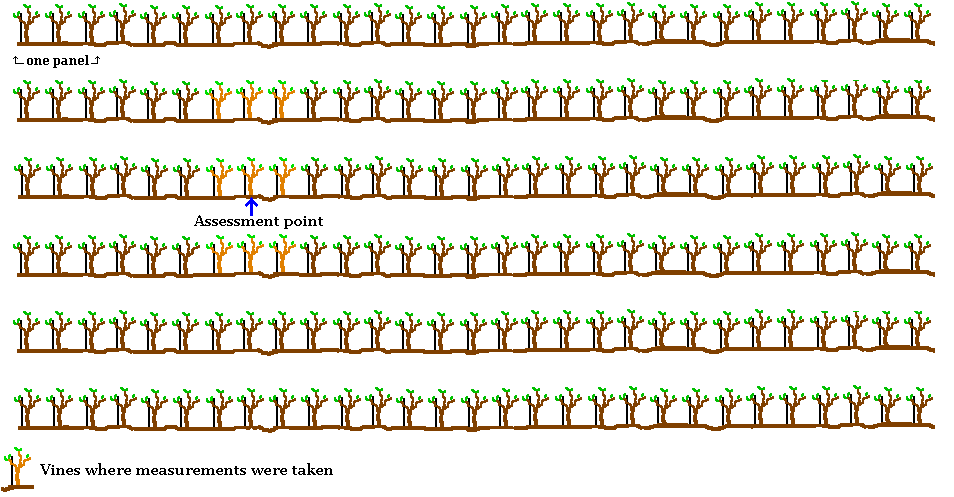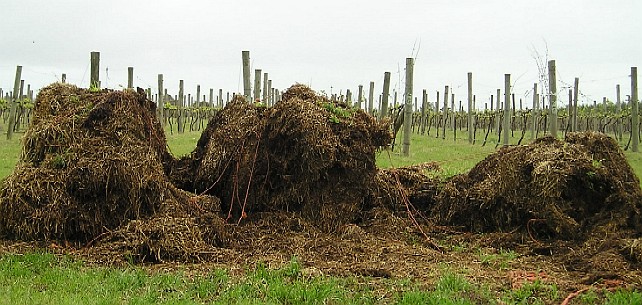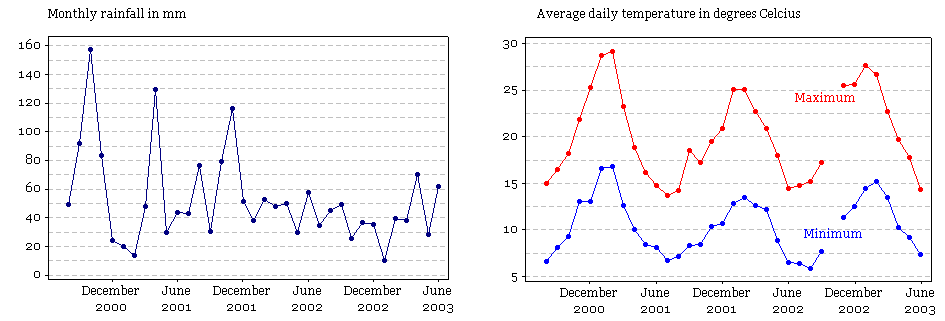Growing better pinot noir – Background
The Vineyard
Vincent works with his family on the vineyard. It is about 40km north of Melbourne, south of the Macedon ranges. The pinot noir vines (D5V12 clone) were planted in 1987 and 1988.
The soil and, in particular, the organic matter in the soil can be easily damaged in the normal course of working the vineyard. Organic matter is important to the quality of the soil. The structure of the soil is also important. The structure is the shape that the soil takes (e.g. crumbly, clay-like, sandy) and it depends on the physical and chemical properties of the soil. For grape-growing, the soil should be able to hold water, efficiently release nutrients and also suppress the growth of weeds.

Setting up the trial
The study was set up on a four hectare block on the vineyard (one hectare is 100m by 100m). Each row in the vineyard includes 100 vines. The rows are 200 metres long with vines planted at 2 metre spacings. The rows are divided into sections 6 metres long called panels. Thus each panel includes 3 vines.
The study compared three under vine treatments – barley straw mulch, compost and a herbicide. Each treatment was applied to 6 adjacent rows of vines within a block.
Assessment points for collecting data about a variety of different outcomes were selected within blocks. Three things were considered in choosing the assessment points: they should not be too close to the edge, they should have the same type of soil, and trunk diameters (an indication of the vigour of the vine) should be similar. The figure below shows an assessment point within a block and the nine vines around the assessment point on which measurements were taken.

Applying the treatments
The barley straw mulch was applied to between 5cm and 10cm thick. A side-throw slasher was used to apply the straw under the vines. This mechanical method had the disadvantage of damaging the straw and, as a result, the straw broke down more rapidly than expected.
The compost (green garden waste) was also applied to between 5cm and 10cm thick. A hopper on a trailer with a conveyor belt placed a mound of compost under the vines.
The herbicide was applied to a half metre wide strip under the vines using a spray cart on a tractor. The herbicide used was “Basta” – a herbicide commonly used with genetically modified crops. Basta usually kills most green plants that have not been genetically modified.

Assessing the treatments
Vincent was interested in many different outcomes that might be affected by the use of different under vine treatments. It was possible that different treatments might have effects on different aspects of the whole grape growing and wine making cycle. The growth of the vine itself was assessed by measuring trunk diameter, and also by recording the growth stage of the vines at particular times. Characteristics of the vines were investigated by taking samples of the petioles; these are the stalks of the leaves. They were sent for chemical analysis. Samples of soil were also sent for chemical analysis. Other characteristics of the soil, such as the amount of bacteria and fungus, were measured. Information was also collected about the grapes. The number and weight of bunches were recorded. When the grapes were juiced, the juice was analysed to investigate properties related to the flavour of the wine.
Vine Growth
Vincent felt that it was important to monitor the growth of the vines as adding mulch to the soil can insulate it. This can delay the bud burst – the emergence of new green leaves from the canes. Addition of mulch sometimes can slow growth in the first season that the mulch is applied.
Petiole Characteristics
The petiole samples were collected in 2001 and again in 2002. Different laboratories analysed the samples in the different years, so the information available about the samples differs slightly from year to year. It is most appropriate to focus on comparisons of the under vine treatments within a given year. Four important nutrients are sodium, magnesium, potassium and calcium. The amount of these nutrients in the petioles was measured. Standards are set for the percentage of each of the nutrients that are adequate for good leaf nutrition. For example, adequate calcium levels are between 1.2% and 2.5%; adequate magnesium levels are about 0.4%, and; adequate potassium levels are between 1.8% and 3%. For sodium, levels are regarded as toxic if they are above 0.5%.
Soil Characteristics
The soil samples were collected in 2001 and again in 2002. As with the petiole samples, different laboratories analysed the samples in the different years, so it is most appropriate to focus on comparisons of the under vine treatments within a given year. Soil characteristics are very important in grape growing. The introduction of organic materials such as compost or straw may have an effect on the composition of the soil. Ideally, the uptake of nutrients from the soil will be improved and other characteristics will not be adversely affected. Vincent asked the analytical laboratories to assess various properties of the solid soil mass. High levels of chloride in the soil can indicate high soil salinity which can “burn” the plants. High levels of potassium in the soil can be absorbed by the plant and the skin of the grapes; this can leech into the wine and eventually form crystals. The phosphorus levels in the soil are related to the growth of the roots. The ratio of calcium to magnesium in the soil is an indicator of the soil’s “health”. If the ratio is very low (say less than 1), the soil can degrade. If the ratio is too high (say greater than 8), it can result in leeching of other nutrients. The laboratory also measured the pH of calcium chloride in the soil. Acidity levels in the soil should not be too extreme and ideally would be between 5.5 and 6. Information about the nutrients in the water in the soil, including sodium, magnesium, potassium and calcium, was obtained. The nutrients in the water in the soil can be absorbed by the plant’s root system.
Harvest
At harvest, Vincent measured the productivity of the wines in terms of how many bunches were produced and the yield of grapes from those bunches. Greater productivity is generally preferable as long as grape quality is sustained, and it was important to investigate the effects of the under vine treatments on yield. As mulch may affect growth in the first season of use, productivity may be reduced. Use of herbicide reduces the competition of the vine with weeds, and the vines may be more productive than those with alternative treatments. However, “green” under vine treatments may enhance nutrition of the vines which might have a positive affect on productivity.
Juice
Click the play button to hear more about the juice. |
Characteristics of the juice are important to the flavour and other properties of the wine. Wine growers usually measure pH to determine the acidity of the juice. Acidity affects chemical reactions and characteristics (such as the colour) of the wine. Wine growers also measure the titration of tartaric acid. This affects the perception of the acidity of the wine on the tongue.
A lower acidity tends to give a better flavour balance, and the level of acidity can influence how sweet or dry the wine tastes. A third standard measure is Brix; it relates to the potential alcohol content of the wine. There are no absolute right or wrong values for these measures; what is appropriate depends on the type of wine desired.
Trials and tribulations
Field trials inevitably face some practical difficulties. Vincent seemed to have his fair share.
Vincent had wanted to collect information about the lengths of the shoots on the vines. However this proved to be impractical as the shoots and vines were damaged while trying to take the measurements.

During the study, areas of Victoria were suffering from drought. In 2001-2003 rainfall in the vineyard was in the lowest 10% of recorded rainfall for the region. This is referred to as a serious deficiency in rainfall. In the vineyard in 2002, for example, 240mm of rain fell during the growing season compared with 476mm in the same period in 2000.
In late Spring 2002, the vineyard was grazed by sheep for three weeks. The drought conditions meant that fodder was in short supply for livestock. The first buds had burst on the vines and the sheep grazed over 70% of the buds. This meant that the yield depended more on the secondary buds which typically produce much less fruit. The effect of the sheep grazing the vineyard was like the effect of a major frost – substantial loss in fruit production.
Panorama of the vineyard
Click the play button to see a panorama of the vineyard. |
